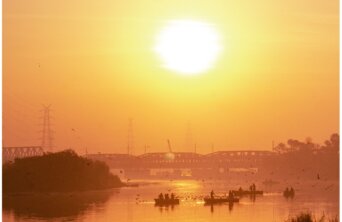- About
- Topics
- Picks
- Audio
- Story
- In-Depth
- Opinion
- News
- Donate
- Signup for our newsletterOur Editors' Best Picks.Send
Read, Debate: Engage.
| topic: | Climate Change |
|---|---|
| located: | India |
| editor: | Hanan Zaffar |
This past week, over 100 people have died in the northern region of India due to heatstroke-related symptoms as a deadly heat wave swept through the country. These deaths caused by the relentless heat of Indian summers are no longer an aberration: casualties due to heatstroke have become a norm during the months of May and June, especially in north India, as average temperatures rise due to the climate crisis.
The tragic, recurring heatwave highlights the urgent need to address climate change and its severe implications on human lives in the country, especially in the worst-affected states in the north. The temperature in most districts of Uttar Pradesh reached 40 degrees Celsius, which is 4.7 degrees above the normal average temperature, and left more than 50 people dead. In other districts across Uttar Pradesh and Bihar, temperatures surpassed 44 degrees Celsius, inciting the Indian Meteorological Department to issue a heatwave alert across northern and central Indian states.
Around 60 people lost their lives in the Uttar Pradesh state while more than 40 people died in Bihar due to the current heatwave. According to doctors, the fatalities were mostly seen in people above 60 years old who were already suffering from some ailments. Most of the deaths were due to heart attack, brain stroke and diarrhoea, as heatstroke worsened their conditions.
According to a UK-based study, “climate change has made record-breaking heat waves in northwest India and Pakistan 100 times more likely. Climate change has contributed majorly to making summer hotter as extreme temperatures would occur once every 312 years without climate change.” It gives us a sense of how extreme the problem is.
Even though climate change is a problem faced by the entire world, India is located in a region which is considered one of the most affected by it. With its diverse geographic features, the country is said to face the brunt of climate change in many forms, be it in the melting of glaciers, flooding of rivers, rise in sea levels or droughts. A UN report released earlier this year warned of irreversible repercussions for India if no drastic action is taken by 2030.
The county has tried to address some problems on its part. For example, India is already shifting towards renewable sources of electricity generation. The Indian government plans to meet 50 percent of the country’s energy needs via non-fossil fuels, amounting to about 500 gigawatts, by 2030. The government has said to reduce its projected carbon emission by 45 percent during the same time period.
However, this is not a single-front battle. As India is the third highest carbon-emitting country and the climate crisis is having a huge impact on the region, the government has to work effectively and quickly. Apart from controlling emissions, the government has to keep a check on unregularised urbanisation, long-term environmental and ecological balance, exploitation of environmental resources, among other issues.
In the short run, the government has to keep hospitals and the healthcare sector up-to-date for any untoward incidents like heatwave deaths. Importantly, it has a responsibility to make people aware of the impact and dangers of heatwaves, as well as the precautions they can take to protect themselves.
Image by Dewang Gupta

